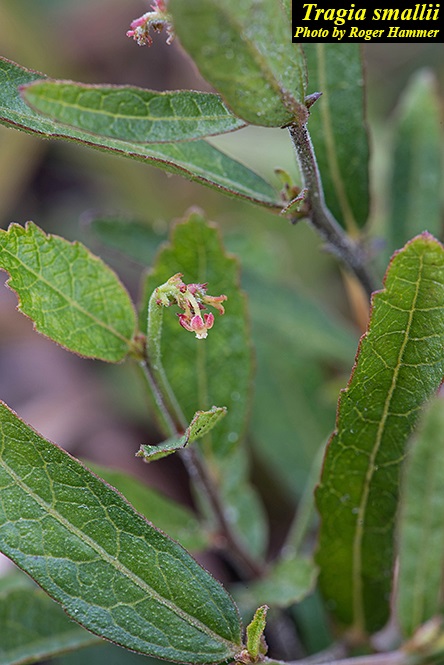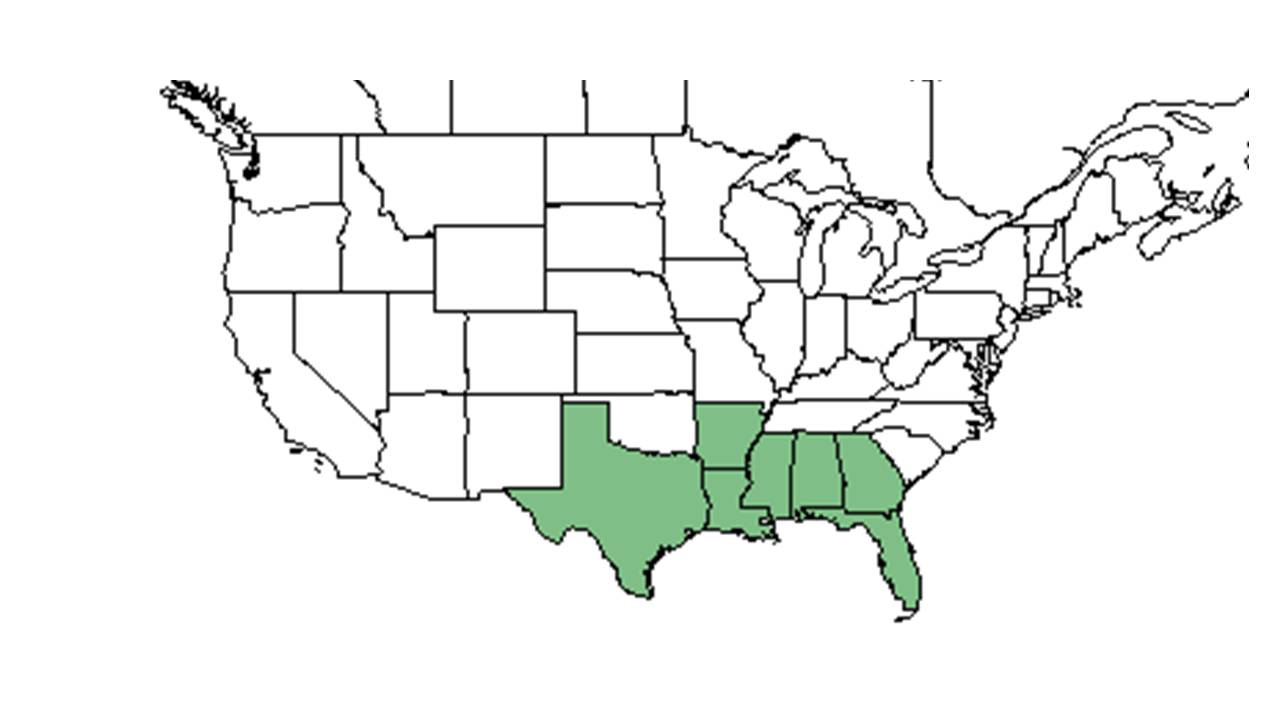Tragia smallii
| Tragia smallii | |
|---|---|

| |
| Photo by Roger Hammer, Atlas of Florida Vascular Plants | |
| Scientific classification | |
| Kingdom: | Plantae |
| Division: | Magnoliophyta – Flowering plants |
| Class: | Magnoliopsida – Dicotyledons |
| Order: | Euphorbiales |
| Family: | Euphorbiaceae |
| Genus: | Tragia |
| Species: | T. smallii |
| Binomial name | |
| Tragia smallii Shinners | |

| |
| Natural range of Tragia smallii from USDA NRCS Plants Database. | |
Common names: Small's noseburn, Gulf Coast noseburn
Contents
Taxonomic notes
Synonym: T. betonicaefolia Nuttall.[1]
Description
Distribution
Ecology
Habitat
In the Coastal Plain in Florida and Georgia, T. smallii can be found in recently burned scrubs, scrub oak-wiregrass communities, wiregrass-pine flatwoods, longleaf pine/wiregrass/scrub oak sandhills, recently burned longleaf pine/wiregrass communities, pine savannas, and around ephemeral ponds.[2][3] It can also be found along old logging roads, recreation areas, and bulldozed wiregrass-pinewoods. Soil types include loamy sand, sand, sandy loam, and loamy soil.[2] T. smallii had variable changes in frequency and density in response to roller chopping in northwest Florida sandhills. It either decreased its occurrence or was unaffected by this practice.[4]
Associated species include Liatris, Panicum, Leptoloma cognata, Sphenopholis nitida, Euphorbia inundata, Paspalum, Rhynchospora, Macbridea, and Justicia crassifolia.[2]
Tragia smallii is an indicator species for the Panhandle Silty Longleaf Woodlands community type as described in Carr et al. (2010).[5]
Phenology
T. smallii has been observed flowering April through October and fruiting April through August.[6]
Seed dispersal
This species is thought to be dispersed by ants and/or explosive dehiscence.[7]
Fire ecology
Populations of Tragia smallii have been known to persist through repeated annual burns.[8] Tragia smallii was found frequently on plots in the Kisatchie National Forest burned 20 times each in March and July from 1962 to 1998, but rarely on plots burned in May.[3]
Conservation, cultivation, and restoration
Cultural use
Photo Gallery
References and notes
- ↑ Weakley, A.S. 2015. Flora of the southern and mid-atlantic states. Working Draf of 21 May 2015. University of North Carolina at Chapel Hill, Chapel Hill, North Carolina.
- ↑ 2.0 2.1 2.2 Florida State University Robert K. Godfrey Herbarium database. URL: http://herbarium.bio.fsu.edu. Last accessed: July 2015. Collectors: Loran C. Anderson, H. E. Grelen, Sidney McDaniel, Angus Gholson, Travis MacClendon, Karen MacClendon, Annie Schmidt. States and Counties: Florida: Calhoun, Franklin, Gadsden, Gulf, Liberty, Okaloosa, Santa Rosa, Wakulla, Walton, Washington. Georgia: Thomas. Compiled by Tall Timbers Research Station and Land Conservancy.
- ↑ 3.0 3.1 Haywood, J. D., F. L. Harris, et al. (2001). "Vegetative response to 37 years of seasonal burning on Louisiana longleaf pine site." Southern Journal of Applied Forestry 25: 122-130.
- ↑ Hebb, E.A. (1971). Site Preparation Decreases Game Food Plants in Florida Sandhills. The Journal of Wildlife Management 35(1):155-162.
- ↑ Carr, S.C., K.M. Robertson, and R.K. Peet. 2010. A vegetation classification of fire-dependent pinelands of Florida. Castanea 75:153-189.
- ↑ Nelson, G. PanFlora: Plant data for the eastern United States with emphasis on the Southeastern Coastal Plains, Florida, and the Florida Panhandle. www.gilnelson.com/PanFlora/ Accessed: 14 DEC 2016
- ↑ Kirkman, L. Katherine. Unpublished database of seed dispersal mode of plants found in Coastal Plain longleaf pine-grasslands of the Jones Ecological Research Center, Georgia.
- ↑ Robertson, K.M. Unpublished data collected from Pebble Hill Fire Plots, Pebble Hill Plantation, Thomasville, Georgia.